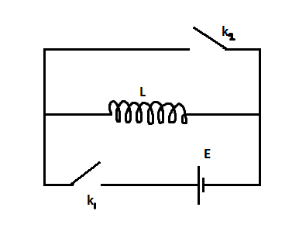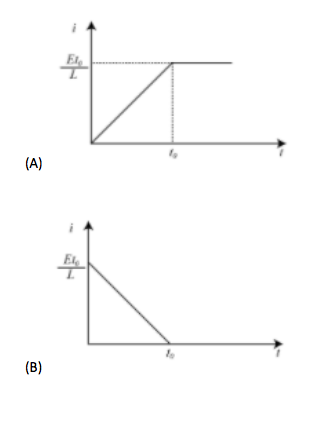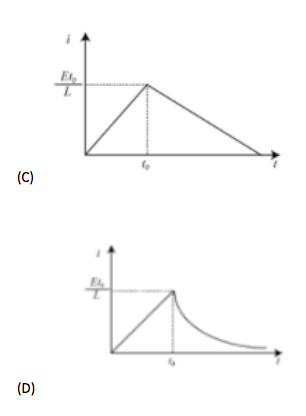Answer
414.6k+ views
Hint: when switch ${k_1}$ is closed an emf is induced in the circuit. Applying the formula of emf for the inductor inducing it, we will establish a relation between inductor current and time.
In the above relation, when the boundary conditions of the second circuit alignment is inputted, we will obtain another relation between current and time.
Formulae used: emf is induced in the circuit: $E = L\dfrac{{di}}{{dt}}$.
Where $E$ is the induced emf and is expressed in Volts $(V)$, $L$ is the inductance and is expressed in Henry $(H)$, $di$ is the change in current and is expressed in Ampere $(A)$ and $dt$ is the time taken for the current to change and is expressed in seconds $(s)$.
Step by step solution:When ${k_1}$ is closed, current flows in the circuit due to the battery connected to it. The presence of the inductance coil creates a magnetic flux, which on changing, results in the induction of an electromagnetic force. This is represented by $E$ and is equal to $L\dfrac{{di}}{{dt}}$.
Applying the boundary condition at $t = 0$ we get,
$
E = L\dfrac{{di}}{{dt}} \\
\Rightarrow di = \dfrac{E}{L} \times dt \\
$
Upon integration within the limits of $0 \to {t_o}$ we get,
$
\Rightarrow {\smallint _0}^{{I_{{t_o}}}}di = {\smallint _0}^{{t_o}}\dfrac{E}{L} \times dt \\
\Rightarrow {I_{{t_o}}} = \dfrac{E}{L}{t_o} \\
$
This linear variation is from $t$ to ${t_o}$.
Now, applying the boundary conditions at $t > {t_o}$ having limits of ${t_o} \to \infty $ we get,
$
E = L\dfrac{{di}}{{dt}} \\
\Rightarrow di = \dfrac{E}{L} \times dt \\
\Rightarrow {\smallint _{{I_{{t_o}}}}}^\infty di = {\smallint ^\infty }_{{t_o}}\dfrac{E}{L} \times dt \\
\Rightarrow {I_\infty } - {I_{{t_o}}} = \dfrac{E}{L}({t_\infty } - {t_o}) \\
$
Which is impossible.
Therefore $L\dfrac{{di}}{{dt}} = 0$ is considered.
This is a constant and therefore there is no variation in inductor current with time.
In conclusion, the correct graph is option A.
Note:The first boundary condition is not $t = 0$. It ranges from $t = 0$ to $t = {t_o}$. Similarly, the second one is also a range, that is, $t = {t_o}$ to $t = {t_\infty }$. Calculations are made to be considered in a given time period and not just at a particular instant of time.
Additional information: A LR circuit is a circuit having a combination of inductor(s) and resistor(s). In AC circuits, they reduce voltage and in DC circuits, the inductor acts as a static resistance. Therefore, the circuit given in the above problem has DC connection because no resistor is present.
In the above relation, when the boundary conditions of the second circuit alignment is inputted, we will obtain another relation between current and time.
Formulae used: emf is induced in the circuit: $E = L\dfrac{{di}}{{dt}}$.
Where $E$ is the induced emf and is expressed in Volts $(V)$, $L$ is the inductance and is expressed in Henry $(H)$, $di$ is the change in current and is expressed in Ampere $(A)$ and $dt$ is the time taken for the current to change and is expressed in seconds $(s)$.
Step by step solution:When ${k_1}$ is closed, current flows in the circuit due to the battery connected to it. The presence of the inductance coil creates a magnetic flux, which on changing, results in the induction of an electromagnetic force. This is represented by $E$ and is equal to $L\dfrac{{di}}{{dt}}$.
Applying the boundary condition at $t = 0$ we get,
$
E = L\dfrac{{di}}{{dt}} \\
\Rightarrow di = \dfrac{E}{L} \times dt \\
$
Upon integration within the limits of $0 \to {t_o}$ we get,
$
\Rightarrow {\smallint _0}^{{I_{{t_o}}}}di = {\smallint _0}^{{t_o}}\dfrac{E}{L} \times dt \\
\Rightarrow {I_{{t_o}}} = \dfrac{E}{L}{t_o} \\
$
This linear variation is from $t$ to ${t_o}$.
Now, applying the boundary conditions at $t > {t_o}$ having limits of ${t_o} \to \infty $ we get,
$
E = L\dfrac{{di}}{{dt}} \\
\Rightarrow di = \dfrac{E}{L} \times dt \\
\Rightarrow {\smallint _{{I_{{t_o}}}}}^\infty di = {\smallint ^\infty }_{{t_o}}\dfrac{E}{L} \times dt \\
\Rightarrow {I_\infty } - {I_{{t_o}}} = \dfrac{E}{L}({t_\infty } - {t_o}) \\
$
Which is impossible.
Therefore $L\dfrac{{di}}{{dt}} = 0$ is considered.
This is a constant and therefore there is no variation in inductor current with time.
In conclusion, the correct graph is option A.
Note:The first boundary condition is not $t = 0$. It ranges from $t = 0$ to $t = {t_o}$. Similarly, the second one is also a range, that is, $t = {t_o}$ to $t = {t_\infty }$. Calculations are made to be considered in a given time period and not just at a particular instant of time.
Additional information: A LR circuit is a circuit having a combination of inductor(s) and resistor(s). In AC circuits, they reduce voltage and in DC circuits, the inductor acts as a static resistance. Therefore, the circuit given in the above problem has DC connection because no resistor is present.
Recently Updated Pages
How many sigma and pi bonds are present in HCequiv class 11 chemistry CBSE

Why Are Noble Gases NonReactive class 11 chemistry CBSE

Let X and Y be the sets of all positive divisors of class 11 maths CBSE

Let x and y be 2 real numbers which satisfy the equations class 11 maths CBSE

Let x 4log 2sqrt 9k 1 + 7 and y dfrac132log 2sqrt5 class 11 maths CBSE

Let x22ax+b20 and x22bx+a20 be two equations Then the class 11 maths CBSE

Trending doubts
Fill the blanks with the suitable prepositions 1 The class 9 english CBSE

At which age domestication of animals started A Neolithic class 11 social science CBSE

Which are the Top 10 Largest Countries of the World?

Give 10 examples for herbs , shrubs , climbers , creepers

Difference between Prokaryotic cell and Eukaryotic class 11 biology CBSE

Difference Between Plant Cell and Animal Cell

Write a letter to the principal requesting him to grant class 10 english CBSE

Change the following sentences into negative and interrogative class 10 english CBSE

Fill in the blanks A 1 lakh ten thousand B 1 million class 9 maths CBSE






